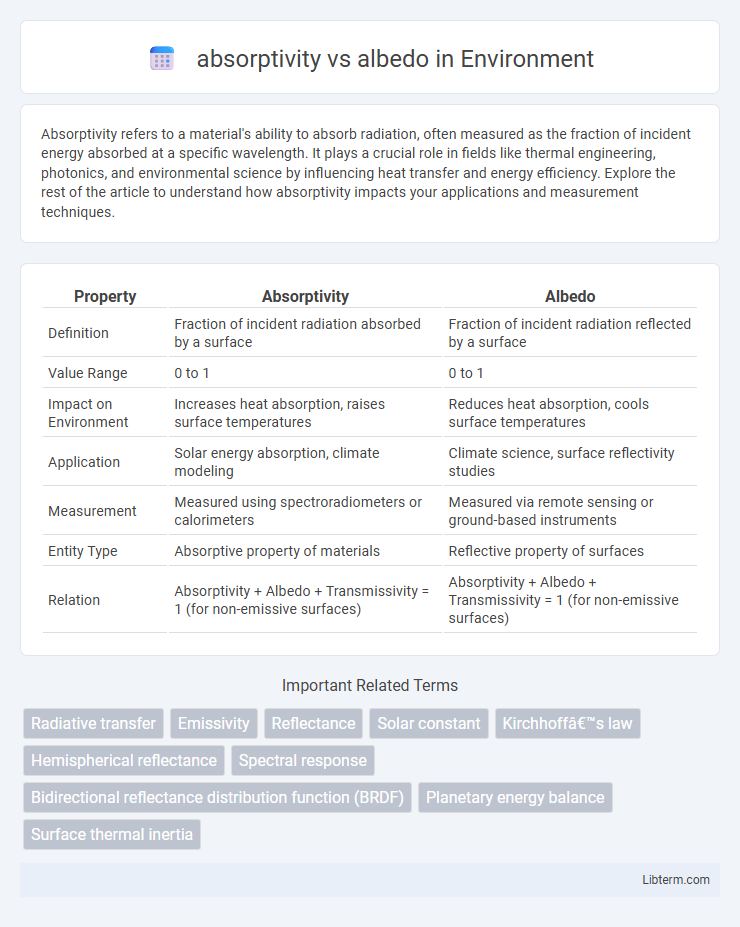Absorptivity refers to a material's ability to absorb radiation, often measured as the fraction of incident energy absorbed at a specific wavelength. It plays a crucial role in fields like thermal engineering, photonics, and environmental science by influencing heat transfer and energy efficiency. Explore the rest of the article to understand how absorptivity impacts your applications and measurement techniques.
Table of Comparison
| Property | Absorptivity | Albedo |
|---|---|---|
| Definition | Fraction of incident radiation absorbed by a surface | Fraction of incident radiation reflected by a surface |
| Value Range | 0 to 1 | 0 to 1 |
| Impact on Environment | Increases heat absorption, raises surface temperatures | Reduces heat absorption, cools surface temperatures |
| Application | Solar energy absorption, climate modeling | Climate science, surface reflectivity studies |
| Measurement | Measured using spectroradiometers or calorimeters | Measured via remote sensing or ground-based instruments |
| Entity Type | Absorptive property of materials | Reflective property of surfaces |
| Relation | Absorptivity + Albedo + Transmissivity = 1 (for non-emissive surfaces) | Absorptivity + Albedo + Transmissivity = 1 (for non-emissive surfaces) |
Introduction to Absorptivity and Albedo
Absorptivity measures the fraction of incident radiation absorbed by a surface, a crucial parameter in energy balance studies. Albedo represents the fraction of solar radiation reflected by a surface, impacting Earth's climate by influencing heat retention and radiation budgets. Understanding the interplay between absorptivity and albedo is essential for modeling surface energy exchanges and assessing environmental and climatic effects.
Defining Absorptivity: Key Concepts
Absorptivity measures a material's ability to absorb incident radiation, expressed as the ratio of absorbed energy to the total incoming energy. Unlike albedo, which quantifies the fraction of radiation reflected by a surface, absorptivity directly relates to energy uptake and thermal response. Key concepts include spectral dependence and temperature influence, critical for applications in climate modeling and solar energy systems.
Understanding Albedo: Meaning and Measurement
Albedo measures the fraction of solar radiation reflected by a surface, ranging from 0 (no reflection) to 1 (total reflection), and is critical in climate studies and planetary science for assessing energy balance. Absorptivity quantifies the proportion of incident radiation absorbed by a material, directly influencing surface temperature and heat retention. Precise measurement of albedo involves spectroradiometers and remote sensing techniques to capture reflectance across different wavelengths, enabling accurate modeling of Earth's radiative processes.
Physical Principles Behind Absorptivity and Albedo
Absorptivity measures the fraction of incident radiation absorbed by a surface, governed by the material's molecular and electronic structure which determines how energy is converted to heat or other forms. Albedo quantifies the proportion of radiation reflected by a surface, influenced by surface texture, color, and angle of incidence according to Fresnel's equations and scattering theory. Both parameters are critical in radiative heat transfer, with absorptivity linked to emissivity through Kirchhoff's law, while albedo primarily affects the Earth's energy balance by controlling reflectivity.
Differences Between Absorptivity and Albedo
Absorptivity measures the fraction of incident radiation absorbed by a surface, directly impacting its thermal energy retention, while albedo quantifies the fraction of incident light reflected by that surface, influencing planetary temperature and climate. Absorptivity values range from 0 to 1, with higher values indicating greater absorption, whereas albedo values also range from 0 to 1 but signify reflectivity, where higher albedo means more reflection and less absorption. These contrasting properties govern energy balance in environmental science and material engineering, affecting processes like heat transfer, surface temperature regulation, and atmospheric studies.
Factors Influencing Absorptivity and Albedo Values
Absorptivity and albedo depend heavily on surface characteristics such as texture, color, and material composition, with darker, rougher surfaces exhibiting higher absorptivity and lower albedo due to increased energy absorption and reduced reflectance. Environmental conditions including angle of solar incidence, atmospheric composition, and surface moisture also alter these properties by affecting how much radiation is absorbed or reflected. Seasonal and geographic variations further influence albedo and absorptivity, as snow cover, vegetation, and urbanization change the reflective and absorptive behavior of surfaces over time.
Applications in Climate Science and Engineering
Absorptivity measures a material's ability to absorb radiation, directly influencing the Earth's energy balance by determining how much solar energy is retained versus reflected. Albedo quantifies the reflectivity of surfaces, with high albedo surfaces like ice caps cooling the planet by reflecting more sunlight, while lower albedo materials such as asphalt increase heat absorption. In climate science and engineering, accurately modeling absorptivity and albedo is crucial for predicting temperature changes, designing energy-efficient buildings, and developing climate mitigation strategies.
Real-world Examples: Earth, Surfaces, and Materials
Earth's absorptivity varies across surfaces; forests and oceans absorb up to 90% of sunlight, while ice and snow reflect most solar radiation, demonstrating high albedo values around 0.6 to 0.9. Urban materials like asphalt exhibit low albedo, typically 0.05 to 0.2, absorbing significant heat and contributing to the urban heat island effect. Understanding the balance between absorptivity and albedo in natural and manmade surfaces is crucial for climate modeling and energy management.
Measuring Techniques for Absorptivity and Albedo
Measuring absorptivity involves using spectrophotometers to analyze the material's ability to absorb radiation across specific wavelengths, often employing integrating spheres for diffuse samples. Albedo measurement typically relies on satellite-based radiometers or ground-based pyranometers to quantify the ratio of reflected to incident solar radiation, with hemispherical sensors capturing diffuse and direct components. Both techniques require calibration against standardized references to ensure accurate assessment of energy balance and surface radiative properties.
Importance in Environmental and Energy Studies
Absorptivity measures the fraction of incident radiation absorbed by a surface, directly affecting heat gain and energy balance in environmental and energy systems. Albedo quantifies reflectivity, influencing climate models by determining how much solar energy is reflected back into the atmosphere, thereby controlling surface temperature and radiative forcing. Understanding the interplay between absorptivity and albedo is crucial for accurate climate predictions, solar energy harvesting efficiency, and managing Earth's energy budget.
absorptivity Infographic

 libterm.com
libterm.com